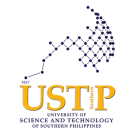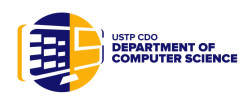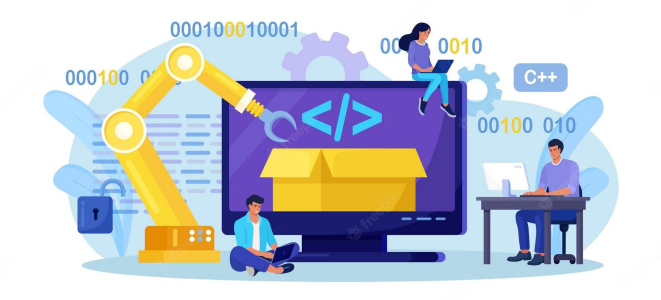Lecture Note 01 Intro to comp

 Introduction to Computing
Introduction to Computing
(CS111)
Junar A. Landicho 

 junarlandicho@ustp.edu.ph
junarlandicho@ustp.edu.ph
“
When we are no longer able to change a situation we are challenged to change ourselves.
Viktor Frankl
Topic 1:
Data Storage
IT 416
Information Systems Development and Management
Learning Outcomes
By the end of this topic, students will be able to: ![]() Create a computational artifact for creative expression.
Create a computational artifact for creative expression. ![]() Describe the variety of abstractions used to represent data.
Describe the variety of abstractions used to represent data.
![]() Explain how binary sequences are used to represent digital data.
Explain how binary sequences are used to represent digital data.
![]() Identify multiple levels of abstractions that are used when writing programs.
Identify multiple levels of abstractions that are used when writing programs.
CS 111 – Introduction to Computing
Learning Outcomes
![]() Analyze how data representation, storage, security, and transmission of data involve computational manipulation of information.
Analyze how data representation, storage, security, and transmission of data involve computational manipulation of information.
![]() Use abstraction to manage complexity in programs.
Use abstraction to manage complexity in programs. ![]() Evaluate the correctness of a program.
Evaluate the correctness of a program.
![]() Employ appropriate mathematical and logical concepts in programming.
Employ appropriate mathematical and logical concepts in programming.
CS 111 – Introduction to Computing
Overview
1. Bits and Their Storage
2. Main Memory
3. Mass Storage
4. Representing Information as Bit Patterns 5. The Binary System
6. Storing Integers
7. Storing Fractions
8. Data and Programming
9. Data Compression
10. Communications Errors
CS 111 – Introduction to Computing
Bits and Their Storage Java 
PHP
Python
CS 111 – Introduction to Computing
Bits and Their Storage
![]() Bit: Binary Digit (0 or 1)
Bit: Binary Digit (0 or 1) ![]()
![]() Bit Patterns are used to represent information
Bit Patterns are used to represent information
▪ Numbers
▪ Text characters
▪ Images
▪ Sound
▪ And others
CS 111 – Introduction to Computing
Boolean Operations
![]() Boolean Operation: An operation that manipulates one or more true/false values
Boolean Operation: An operation that manipulates one or more true/false values
![]() Specific operations
Specific operations ![]()
▪ AND
▪ OR
▪ XOR (exclusive or)
▪ NOT
CS 111 – Introduction to Computing
Boolean Operations
![]() The possible input
The possible input ![]()
and output values of
Boolean operations
AND, OR, and XOR
(exclusive or)
CS 111 – Introduction to Computing
Gates
![]() Gate: A device that computes a
Gate: A device that computes a
Boolean operation ![]()
![]() Often implemented as small electronic
Often implemented as small electronic
circuits called transistors
![]() Can be constructed from a variety of
Can be constructed from a variety of
other technologies
![]() Provide the building blocks from which
Provide the building blocks from which
computers are constructed
CS 111 – Introduction to Computing
Gates
![]()
![]()
A pictorial representation of AND, OR, XOR, and NOT gates as well as their input and output values
CS 111 – Introduction to Computing
Flip-flops
![]() Circuits built from gates that act as a
Circuits built from gates that act as a ![]()
fundamental unit of computer memory
▪ One input line is used to set its stored
value to 1
▪ One input line is used to set its stored
value to 0
▪ While both input lines are 0, the most
recently stored value is preserved
CS 111 – Introduction to Computing
Flip-flops
![]() A simple flip-flop circuit
A simple flip-flop circuit
CS 111 – Introduction to Computing
Setting the output of a Flip-flop to 1![]() CS 111 – Introduction to Computing
CS 111 – Introduction to Computing
Setting the output of a Flip-flop to 1 (continued)
![]() CS 111 – Introduction to Computing
CS 111 – Introduction to Computing
Setting the output of a Flip-flop to 1 (continued)
![]() CS 111 – Introduction to Computing
CS 111 – Introduction to Computing
Another way of constructing a flip-flop![]() CS 111 – Introduction to Computing
CS 111 – Introduction to Computing
Hexadecimal Notation
![]() Hexadecimal notation: A shorthand notation for long bit patterns
Hexadecimal notation: A shorthand notation for long bit patterns ![]()
▪ Divides a pattern into groups of four bits each
▪ Represents each group by a single symbol ![]() Example: 10110101 becomes 0xB5
Example: 10110101 becomes 0xB5
CS 111 – Introduction to Computing
Main Memory Java ![]()
PHP
Python
CS 111 – Introduction to Computing
Main Memory
![]() Cell: A unit of main memory (typically
Cell: A unit of main memory (typically ![]()
8 bits which is one byte)
▪ Most significant bit: the bit at the left (high
order) end
▪ Least significant bit: the bit at the right
(low-order) end
CS 111 – Introduction to Computing
Main Memory
![]() The organization of a byte-size memory cell
The organization of a byte-size memory cell
CS 111 – Introduction to Computing
Main Memory Addresses
![]() Address: A “name” that uniquely
Address: A “name” that uniquely ![]()
identifies one cell in the computer’s
main memory
▪ The names are actually numbers.
▪ These numbers are assigned
consecutively starting at zero.
▪ Numbering the cells in this manner
associates an order with the memory
Memory cells arranged by address cells.
CS 111 – Introduction to Computing
Memory Terminology
![]() Random Access Memory (RAM):
Random Access Memory (RAM): ![]()
Memory in which individual cells can
be easily accessed in any order
![]() Dynamic Memory (DRAM): RAM
Dynamic Memory (DRAM): RAM
composed of volatile memory
CS 111 – Introduction to Computing
Measuring Memory Capacity
![]() Kilobyte: 210 bytes = 1024 bytes
Kilobyte: 210 bytes = 1024 bytes ![]()
▪ Example: 3 KB = 3 times1024 bytes
![]() Megabyte: 220 bytes = 1,048,576 bytes
Megabyte: 220 bytes = 1,048,576 bytes
▪ Example: 3 MB = 3 times 1,048,576 bytes
![]() Gigabyte: 230 bytes = 1,073,741,824 bytes
Gigabyte: 230 bytes = 1,073,741,824 bytes
▪ Example: 3 GB = 3 times 1,073,741,824 bytes
CS 111 – Introduction to Computing
Measuring Memory Capacity ![]() Additional devices:
Additional devices:
▪ Magnetic disks ▪ CDs
▪ DVDs
▪ Magnetic tapes ▪ Flash drives ![]()
▪ Solid-state drives
![]() Advantages over main memory ▪ Less volatility
Advantages over main memory ▪ Less volatility ![]()
▪ Larger storage capacities
▪ Low cost
▪ In many cases can be removed
CS 111 – Introduction to Computing
Mass Storage Java ![]()
PHP
Python
CS 111 – Introduction to Computing
Mass Storage Performance
![]() Bandwidth: The total amount of bits that can be transferred in a unit of time
Bandwidth: The total amount of bits that can be transferred in a unit of time ![]()
![]() Latency: The total time between the request for data transfer and its arrival
Latency: The total time between the request for data transfer and its arrival![]()
CS 111 – Introduction to Computing
A Magnetic Disk Storage System![]() CS 111 – Introduction to Computing
CS 111 – Introduction to Computing
CD storage
![]() CS 111 – Introduction to Computing
CS 111 – Introduction to Computing
Flash Drives
![]() Flash Memory – circuits that traps electrons in tiny silicon dioxide chambers
Flash Memory – circuits that traps electrons in tiny silicon dioxide chambers ![]()
![]() Repeated erasing slowly damages the media
Repeated erasing slowly damages the media
![]() Mass storage of choice for: ▪ Digital cameras
Mass storage of choice for: ▪ Digital cameras
▪ Smartphones
![]() SD Cards provide GBs of storage
SD Cards provide GBs of storage
CS 111 – Introduction to Computing
Representing Information as Bit Patterns
Python![]()
Java
PHP
CS 111 – Introduction to Computing
Representing Information as Bit Patterns
![]() Many different kinds of information
Many different kinds of information ![]()
can be encoded as bit patterns
![]() Systems for encoding information
Systems for encoding information
have been established for
▪ Text
▪ Numeric Data
▪ Images
▪ Sound
▪ Other data
CS 111 – Introduction to Computing
Representing Text
Each character (letter, punctuation, etc.) is assigned a unique bit pattern.
![]() ASCII: Uses patterns of 7-bits to represent most symbols used in written English text
ASCII: Uses patterns of 7-bits to represent most symbols used in written English text
![]() ISO developed a number of 8 bit extensions to ASCII, each designed to accommodate a major language group
ISO developed a number of 8 bit extensions to ASCII, each designed to accommodate a major language group
![]() Unicode: Uses patterns up to 21-bits to represent the symbols used in
Unicode: Uses patterns up to 21-bits to represent the symbols used in
languages world wide, 16-bits for world’s commonly used languages
![]()
![]() The message “Hello.” in ASCII or UTF-8 encoding
The message “Hello.” in ASCII or UTF-8 encoding
CS 111 – Introduction to Computing
Representing Numeric Values
![]() Binary notation: Uses bits to
Binary notation: Uses bits to ![]()
represent a number in base two
▪ All numeric values in a computer are
stored in sequences of 0s and 1s
▪ Counting from 0 to 8:
▪ 0000, 0001, 0010, 0011, 0100, 0101,
0110, 0111, 1000
CS 111 – Introduction to Computing
Representing Images
![]() Bit map techniques
Bit map techniques ![]()
▪ Pixel: “picture element” represents one dot ▪ RGB: Red, Green, and Blue components ▪ Luminance and chrominance
▪ Problems with scaling up images
![]() Vector techniques
Vector techniques
▪ Represent images with geometric
structures
▪ Scalable
▪ TrueType and PostScript
CS 111 – Introduction to Computing
Representing Sound
![]() Sampling techniques that record
Sampling techniques that record ![]()
actual audio
▪ Long-distance telephone: 8000
samples/sec
▪ CD sound: 44,100 samples/sec
![]() MIDI stores directions for making
MIDI stores directions for making
sound
The sound wave represented by the sequence 0, 1.5, 2.0, 1.5, 2.0, 3.0, 4.0, 3.0, 0
▪ Used in music synthesizers
▪ Encodes which instrument, note, and duration
CS 111 – Introduction to Computing
The Binary System Java ![]()
PHP
Python
CS 111 – Introduction to Computing
Binary Notation
![]() The traditional decimal system is based on powers of ten.
The traditional decimal system is based on powers of ten. ![]() The Binary system is based on powers of two.
The Binary system is based on powers of two.
![]() CS 111 – Introduction to Computing
CS 111 – Introduction to Computing
Binary Notation
Decoding the binary representation 100101
![]() CS 111 – Introduction to Computing
CS 111 – Introduction to Computing
Binary Notation
An algorithm for finding the binary representation of a positive integer.
![]() CS 111 – Introduction to Computing
CS 111 – Introduction to Computing
Binary Notation
Applying the algorithm in Slide 41 to obtain the binary ![]()
representation of thirteen
CS 111 – Introduction to Computing
Binary Addition & Fractions
The binary addition facts Decoding the binary representation 101.101![]()
![]() CS 111 – Introduction to Computing
CS 111 – Introduction to Computing
Storing Integers Java ![]()
PHP
Python
CS 111 – Introduction to Computing
Two’s Complement ![]()
Notation
![]() Two’s complement notation:
Two’s complement notation:
The most popular means of
representing integer values
![]() Excess notation: Another
Excess notation: Another
means of representing integer
values
Two’s complement notation systems
CS 111 – Introduction to Computing
Two’s Complement Notation Coding the value -6 in two’s complement notation using four bits
![]() CS 111 – Introduction to Computing
CS 111 – Introduction to Computing
Addition in Two’s Complement Notation ![]()
Addition problems converted to two’s complement notation
CS 111 – Introduction to Computing
The Problem of Overflow
![]() There is a limit to the size of the values that can be represented in any system
There is a limit to the size of the values that can be represented in any system ![]()
![]() Overflow
Overflow
▪ occurs when a computation produces a value that falls outside the range of values that can be represented in the machine
▪ If the resulting sign bit is incorrect, an overflow has occurred
▪ 16 bit systems have been upgraded to 32 bit systems
CS 111 – Introduction to Computing
Excess Notation
An excess eight conversion table An excess notation system using bit patterns of length three
![]()
![]() CS 111 – Introduction to Computing
CS 111 – Introduction to Computing
Storing Fractions Java ![]()
PHP
Python
CS 111 – Introduction to Computing
Floating-Point Notation
![]() Floating-point Notation: Consists of a sign bit, a mantissa field, and an exponent field.
Floating-point Notation: Consists of a sign bit, a mantissa field, and an exponent field.
![]() Normalized form: fill the mantissa starting with the left-most 1
Normalized form: fill the mantissa starting with the left-most 1
Floating-point notation components![]()
CS 111 – Introduction to Computing
Truncation Errors
Encoding the value 2 5⁄8
![]()
CS 111 – Introduction to Computing
Truncation Errors
![]() Occur when part of the value being stored is lost because the mantissa is not large enough
Occur when part of the value being stored is lost because the mantissa is not large enough ![]()
![]() Non-terminating expansions of fractions ▪ This happens more often with binary notation
Non-terminating expansions of fractions ▪ This happens more often with binary notation
▪ The value of one-tenth cannot be stored exactly binary notation
▪ Often these values are converted to integers
CS 111 – Introduction to Computing
Numerical Analysis
![]() The study of dealing with problems
The study of dealing with problems ![]()
when computing large values that
require significant accuracy
![]() The order in which values are added
The order in which values are added
can lead to two different results
![]() Adding very small values to very
Adding very small values to very
large values can result in errors
CS 111 – Introduction to Computing
Data and Programming Java ![]()
PHP
Python
CS 111 – Introduction to Computing
Data and Programing ![]()
![]() A programming language is a computer system created to allow humans to precisely express algorithms using a higher level of abstraction.
A programming language is a computer system created to allow humans to precisely express algorithms using a higher level of abstraction.
CS 111 – Introduction to Computing
Programming Languages
![]() CS 111 – Introduction to Computing
CS 111 – Introduction to Computing
Getting Started with Python
![]() Python: a popular programming
Python: a popular programming
language for applications, scientific
computation, and as an introductory
language for students
![]() Freely available from www.python.org
Freely available from www.python.org
![]() Python is an interpreted language
Python is an interpreted language
▪ Typing:
print('Hello, World!')
▪ Results in:
Hello, World!
CS 111 – Introduction to Computing
Getting Started with Python
![]() Variables: name values for later use
Variables: name values for later use
![]() Analogous to mathematic variables in
Analogous to mathematic variables in
algebra
s = 'Hello, World!'
print(s)
my_integer = 5
my_floating_point = 26.2
my_Boolean = True
my_string = 'characters'
my_integer = 0xFF
CS 111 – Introduction to Computing
Getting Started with Python
![]() Operators and Expressions
Operators and Expressions
print(3 + 4) # Prints 7
print(5 – 6) # Prints -1
print(7 * 8) # Prints 56
print(45 / 4) # Prints 11.25
print(2 ** 10) # Prints 1024
s = 'hello' + 'world'
s = s * 4
print(s)
CS 111 – Introduction to Computing
Getting Started with Python
![]() Currency Conversion
Currency Conversion
# A converter for currency exchange.
USD_to_GBP = 0.66 # Today's exchange rate
GBP_sign = '\u00A3' # Unicode value for £
dollars = 1000 # Number dollars to convert
# Conversion calculations
pounds = dollars * USD_to_GBP
# Printing the results
print('Today, $' + str(dollars))
print('converts to ' + GBP_sign + str(pounds))
CS 111 – Introduction to Computing
Getting Started with Python
Debugging
![]() Syntax errors
Syntax errors
print(5 +)
SyntaxError: invalid syntax
pront(5)
NameError: name 'pront' is not defined
![]() Semantic errors
Semantic errors
▪ Incorrect expressions like
total_pay = 40 + extra_hours * pay_rate
![]() Runtime errors
Runtime errors
▪ Unintentional divide by zero
CS 111 – Introduction to Computing
Data Compression Java ![]()
PHP
Python
CS 111 – Introduction to Computing
Data Compression
![]() Lossy versus lossless
Lossy versus lossless
![]() Run-length encoding
Run-length encoding ![]()
![]() Frequency-dependent encoding (Huffman codes)
Frequency-dependent encoding (Huffman codes)
![]() Relative encoding
Relative encoding
![]() Dictionary encoding (includes adaptive dictionary encoding such as LZW encoding)
Dictionary encoding (includes adaptive dictionary encoding such as LZW encoding)
CS 111 – Introduction to Computing
Compressing Images
![]() GIF: Good for cartoons
GIF: Good for cartoons ![]()
![]() JPEG: Good for photographs
JPEG: Good for photographs
![]()
![]()
![]() TIFF: Good for image archivingCS 111 – Introduction to Computing
TIFF: Good for image archivingCS 111 – Introduction to Computing
Compressing Audio and Video
![]() MPEG
MPEG ![]()
![]()
▪ High definition television broadcast
▪ Video conferencing
![]() MP3
MP3
▪ Temporal masking
▪ Frequency masking
CS 111 – Introduction to Computing
Communication Errors Java ![]()
PHP
Python
CS 111 – Introduction to Computing
Communication Errors
![]() Goal: To reduce errors and increase the reliability of computing
Goal: To reduce errors and increase the reliability of computing ![]()
equipment
![]() Parity bits (even versus odd)
Parity bits (even versus odd)
![]() Checkbytes
Checkbytes
![]() Error correcting codes
Error correcting codes
![]() Hamming Distance
Hamming Distance
CS 111 – Introduction to Computing
Parity Bits
The ASCII codes for the letters A and F adjusted for odd parity
![]() CS 111 – Introduction to Computing
CS 111 – Introduction to Computing
Error-Correcting Codes
An error-correcting code Decoding the pattern 010100 using the code ![]()
![]() CS 111 – Introduction to Computing
CS 111 – Introduction to Computing
CS 111 – Introduction to Computing
</End>
![]()
![]()